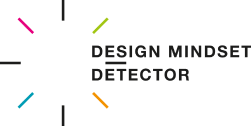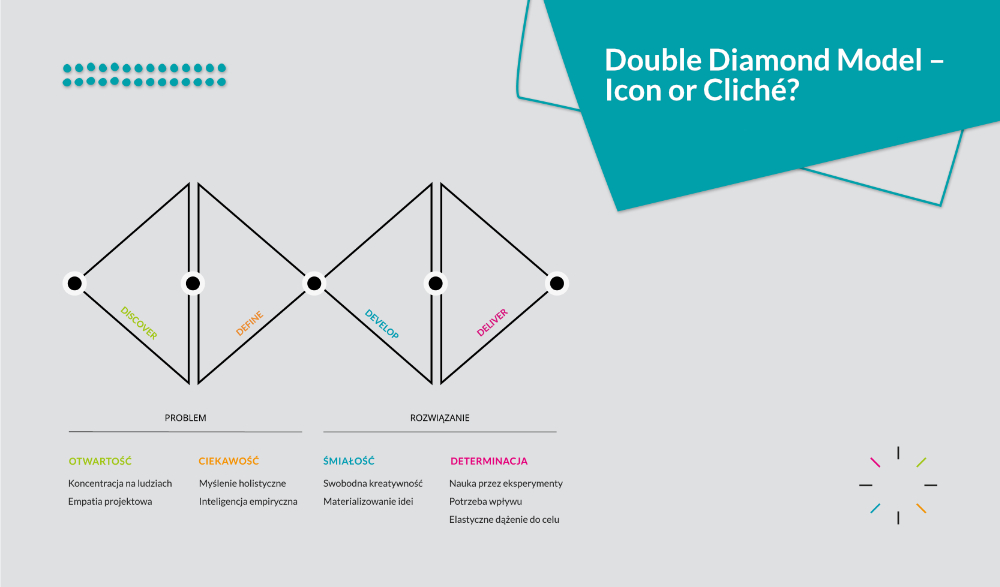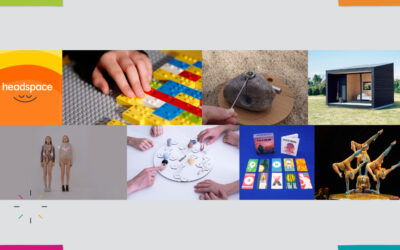It is hard to find a service designer or a Design Thinking practitioner who has not encountered the Double Diamond model, which describes four phases of the design process. For over a decade worldwide, this model has been considered a universal tool for visualizing the process, helping to explain the key principles of design and innovation. But is this model still relevant today?
Contents
- The origins of the Double Diamond model
- The genesis of the Double Diamond
- Double Diamond – process or result?
- What is and isn’t the Double Diamond?
- Double Diamond and the (Un)certainty Matrix
- A universal model
With the emergence of lean and agile methods in our design tools, it is worth asking whether the Double Diamond can still be considered an icon or has become an outdated cliché?
The origins of the Double Diamond model
Before answering the main question, let’s consider who is behind the Double Diamond model. It is not the work of a single person. The Double Diamond is a result of collaboration, based on a thorough analysis of numerous projects conducted by people associated with the Design Council in London. If you want to learn more about how the Double Diamond was created, I recommend Jonathan Ball’s article “From humble beginnings to a cornerstone of design language” and Cat Drew, current Chief Design Officer at Design Council, “The Double Diamond, 15 years on”.
A few years ago, while working at the Design Council, I had the opportunity to meet some of the contributors to the Double Diamond, including Jonathan Ball – an independent Design Strategist, trained as a product designer. Jonathan was a member of an interdisciplinary group called Design Associates, specialists working on a variety of projects conducted by the Design Council at that time. I met Jonathan in 2007, shortly after the Design Council published the Double Diamond, which was created in 2003-2004. Although this simple yet brilliant diagram has been used by both designers and others for many years, more critical voices are now being heard.
The genesis of the Double Diamond
We met with Jonathan and Magda Kochanowska online to discuss the genesis of the Double Diamond. We also wanted to know how Jonathan assesses the relevance of this model in the context of the diverse challenges we currently face professionally.
Our conversation began with the statement that the Double Diamond was not “created” from scratch by the Design Council (more on this can be found in the previously mentioned articles by Jonathan and Cat Drew). Diamond-shaped diagrams and the basic concept of divergent and convergent thinking were already used, including in the works of Victor Papanek in the 1970s. In his text, Jonathan quotes the words of Richard Eisermann, former Director of Design and Innovation at the Design Council:
“The [Design Council] team worked on defining design, the design process, its methods, etc. What we did with the Double Diamond was to standardize [the process], give new names to the stages, and popularize [the diagram]. It was very important work, but undoubtedly built on the foundations laid by past giants [of design].”
In short: the Double Diamond identifies four key phases of the design process:
- Discover,
- Define,
- Develop,
- Deliver.
Double Diamond – process or result?
Jonathan points out that the narrative of the design process comes directly from industrial design, where we strive for a physical, tangible effect. In this context, Jonathan mentions the challenges associated with fields such as service design. Somewhat controversially, he states:
“Service Design often does not deliver expected results. There is a lot of talk about strategies and innovations, but there is a lack of understanding of how to achieve the final effect.”
Although this opinion may be difficult to accept, Jonathan raises an important point. The Double Diamond process does not end after creating a report or service design. Numerous activities follow to make the work tangible. This observation also highlights another important gap we often observe.
Companies hire service designers to help them develop innovative solutions or improve existing ones. However, after research, development, and testing, the entire implementation process remains on the company’s side. Sometimes implementation is handed over to other teams that did not have the opportunity to collaborate on the solution and are unfamiliar with the research or context. In such situations, failures can occur. It is still rare for the team, including service designers who worked on developing the solution, to also participate in the implementation phase. This aspect leads us to some of the criticisms of the Double Diamond model mentioned at the beginning of the text.
Read also: Sustainable design mindset – The role of a sustainable approach to design
What is and isn’t the Double Diamond?
Some believe that this model suggests linearity, often saying, “Isn’t this just waterfall?”. Others add additional “diamonds” at the beginning and end of the Double Diamond to show that more happens in projects than just the four main phases depicted in the model. While we understand why this happens, it is worth remembering that the Double Diamond model is a visualization of the design process – a diagram meant to show the way of working. It is a reference point, not a detailed step-by-step manual.
One of the key aspects illustrated by the Double Diamond is showing the importance of questioning our own assumptions at the beginning of a project. Through successive steps, alternating divergent and convergent thinking, we define a design challenge based on real user needs, not just assumptions. Speaking about this, Jonathan recalls a workshop he conducted a few years ago in Asia. Participants were tasked with questioning the brief and the proposed methods for the project, which caused discomfort. The preference was to execute the task according to the provided brief without any questioning. How did Jonathan convince them to approach it differently? He drew the Double Diamond model, starting from the end.
He first drew a simple line from point A to B, illustrating how things often happen in many cases.
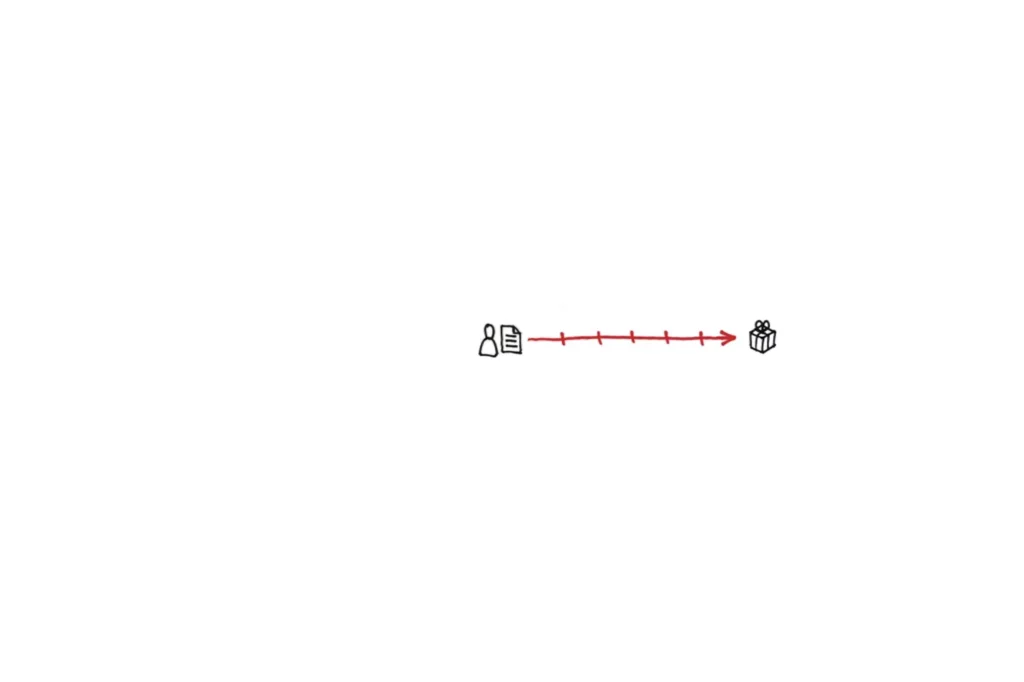
Next, he drew the lines of the second “diamond”.
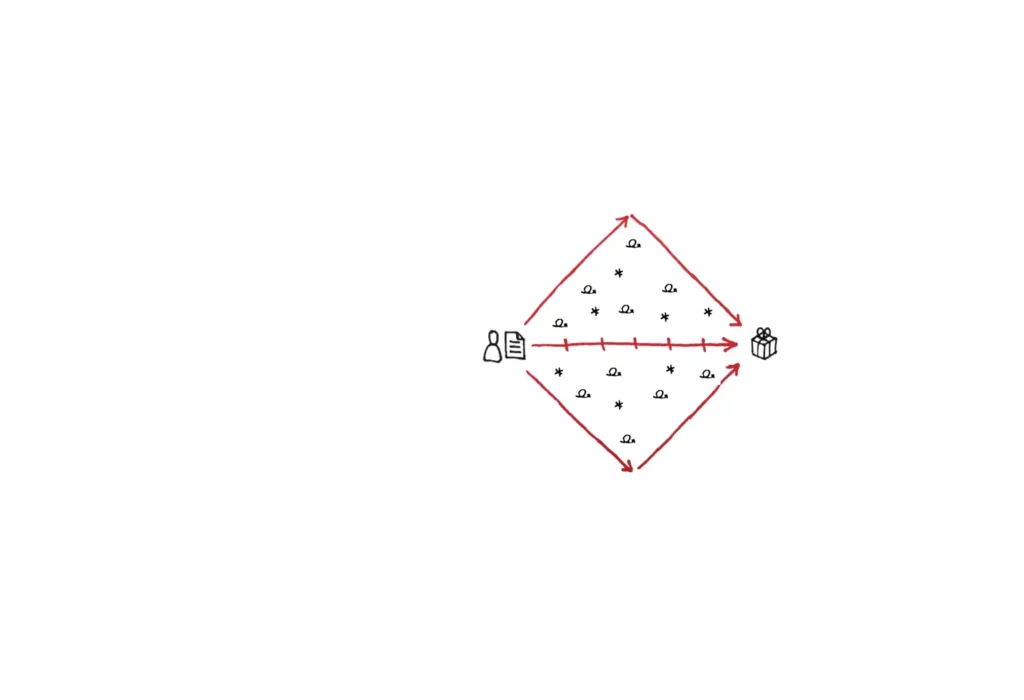
While drawing, Jonathan explained that the Double Diamond helps challenge the status quo and the standard way of dealing with challenges, instead of immediately jumping to conclusions and solutions.
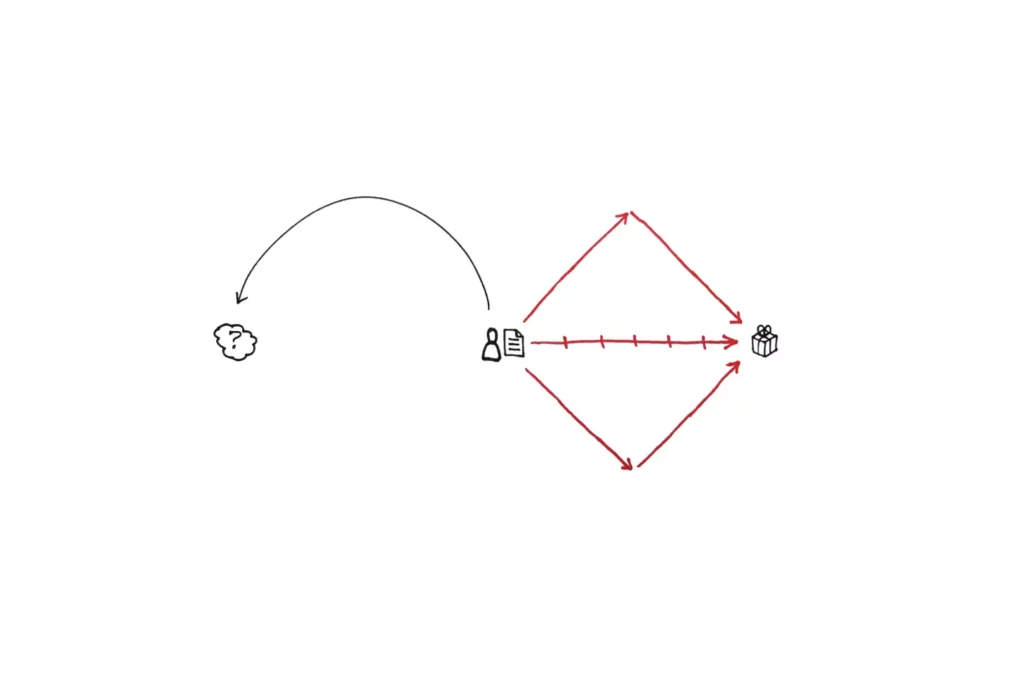
Jonathan points out that especially for non-designers:
“The first phase of the Double Diamond is the most discouraging, but also exciting, because it is usually somehow invisible. The Double Diamond made people see it and understand why it is important.”
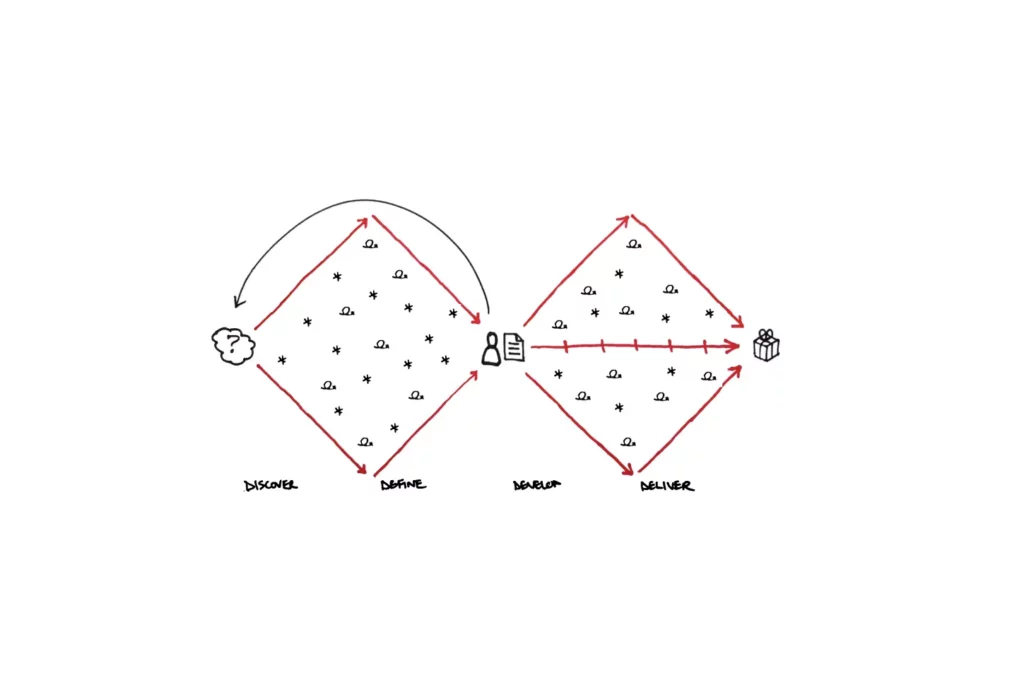
When asked how he assesses the relevance of the Double Diamond model in the context of current design challenges, Jonathan responds:
“The Double Diamond is adaptable depending on the project. It will change – that’s why it cannot become a cliché. It is a tool that is constantly evolving.“
He adds:
“Never plan a project from start to finish, detailing every step. Design challenges are not science, although the principle is the same: questions and hypotheses, and then methods to solve them. Every prescription is limiting, and after obtaining an answer, another question and hypothesis usually arise. You need to question, ask yourself if something should be transformed, adapt the design process in another way.”
Double Diamond and the (Un)certainty Matrix
Jonathan presents another way to use the Double Diamond model, referring to the level of certainty we have in a project. The Double Diamond provides us with a structure for projects where the level of certainty about the final outcome is quite low, or even very low. Jonathan’s collaborator, David Townson from What Could Be, illustrated this as follows:
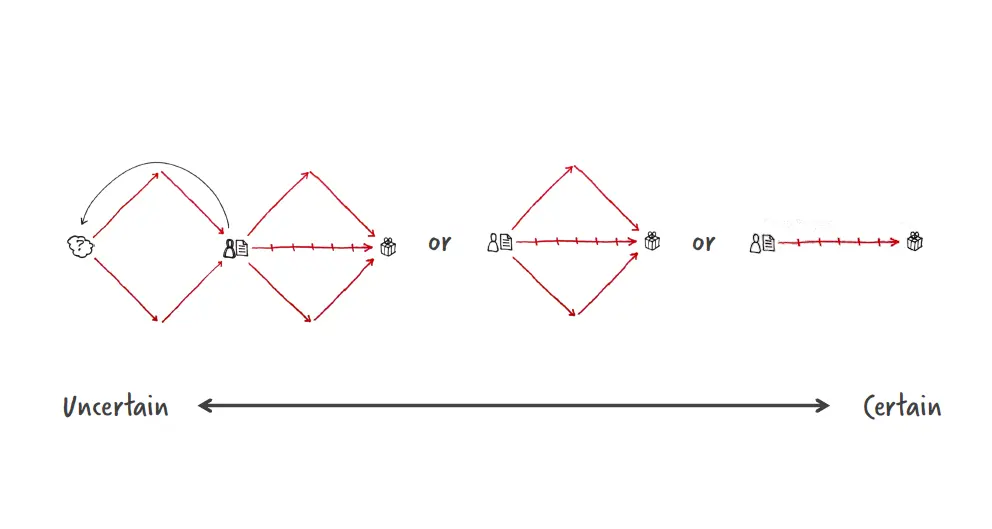
And…
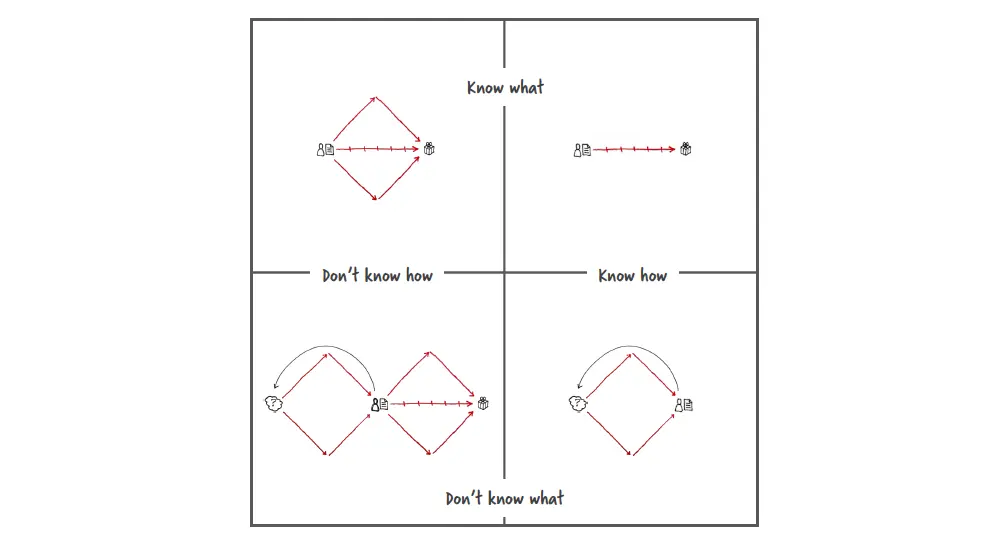
Recently, Jonathan and his colleagues from What Could Be went a step further, using the Double Diamond model to create the Design Thinking Canvas. This tool is based on four key questions that every team needs to ask at the beginning of a project:
-
- What is our vision? Where are we heading?
-
- What will be the project’s outcome? What will it change?
-
- What challenges require our attention? What barriers and obstacles do we face?
-
- Who is involved in this project? Who will it affect? Who will be working on it?
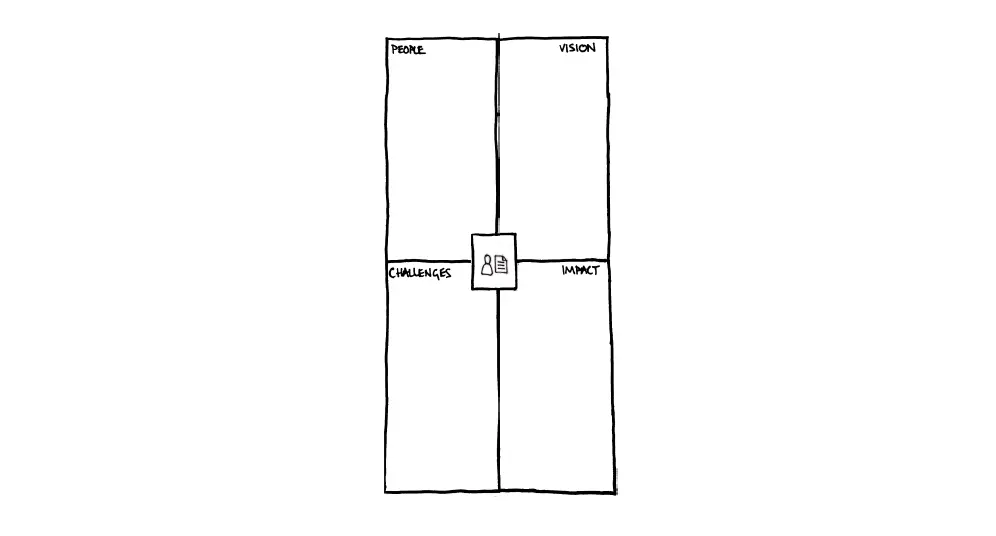
Two additional questions:
-
- How will communication look during this project (storytelling)?
-
- How will we deliver the project’s results and measure its development (management)?
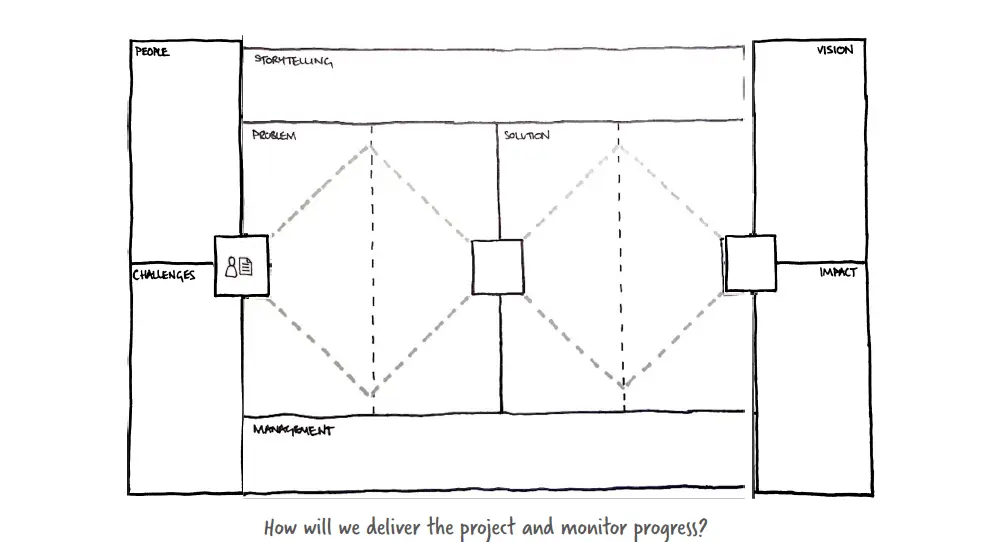
Combining the Double Diamond model, which is at the center, with this canvas creates a starting point for various projects we can imagine. It presents itself as a combination of the process visualization and the Scoping Canvas.
The Design Thinking Canvas is available under a Creative Commons license at www.designthinkingcanvas.co.uk
.co.uk and through the MURAL template library.
A universal model
The conversation with Jonathan, an experienced strategic design practitioner with over 30 years of professional experience, confirmed that the Double Diamond model is an extremely useful and flexible tool, allowing for the explanation of key features of the design process. The Double Diamond is not a ready-made project plan, as it was not created for that purpose. While it can be argued that the model suggests a linear approach, this seems to depend solely on the narrative adopted during its discussion. The design process is inherently iterative, and iteration is embedded in its DNA. It is exploratory, experimental, full of surprises and diverse challenges encountered during implementation.
Considering all these aspects, the Double Diamond model is brilliant in its simplicity, allowing for the illustration of the main principles of the design process, while also providing sufficient flexibility in its application.
* The inspiration for the title was a presentation that Jonathan Ball gave in May 2020 at EIMAD (Encontro de Investigação em Música, Artes e Design) in Portugal.
** The article includes illustrations by David Townson from What Could Be. We are very grateful to David and Jonathan for allowing us to include them in this text.
